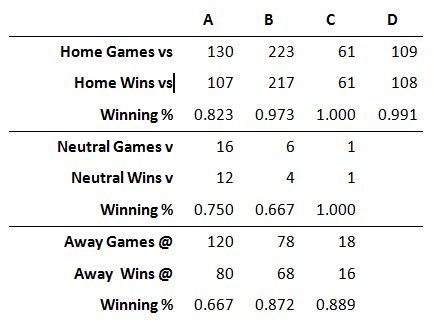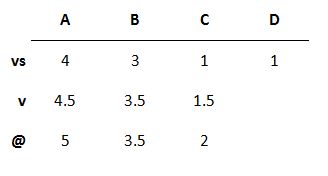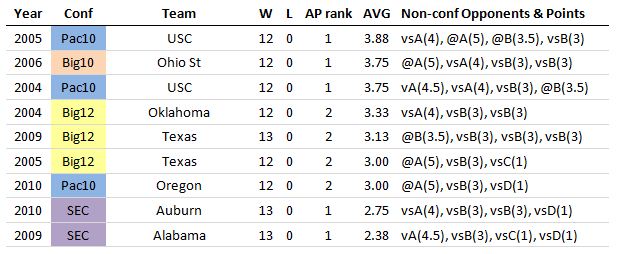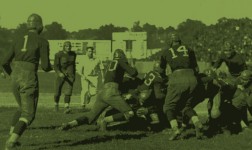With the decision to go to a 4-team playoff starting with the 2014 season, it seems that college football is giving more teams a shot at the national championship. In some ways, this is true – a 4-team playoff does include twice as many teams as the current 2-team playoff that the BCS technically consists of. How those four teams are going to be selected will be debated and finalized in the next year or so, but do the impending changes mean that teams need to radically rethink their scheduling philosophy? 1 Absolutely not. Here’s why.
We looked at all non-conference games of the AP Top 25 teams from 2003-2010 (looking at the last regular season rankings), dividing their opponents into four groups:
Group A = High quality BCS teams (BCS teams with at least one season over .500 in their previous five)
Group B = High quality non-BCS teams and Low quality BCS teams (non-BCS teams with at least one season over .500 in their previous five and BCS teams with no .500 seasons in their previous five)
Group C = Low quality non-BCS teams (non- BCS teams with no .500 seasons in their previous five)
Group D = FCS teams
We then determined how tough it was for Top 25 teams to defeat these opponents, and found:
 Based on these figures, we set the following points from 5 to 1:
Based on these figures, we set the following points from 5 to 1:
 These points signify the two most important aspects of a non-conference schedule, risk and reward. 2 The points are identically situated, in that the higher the number, the higher the risk of losing the game, but also the most reward if a team wins. The lower the number, the lower the risk of losing the game, but the lower the reward for winning. So defeating an “A” team on the road carries a risk of 5, but a reward of 5 as well. Defeating a “D” team at home is the lowest risk and the lowest reward.
These points signify the two most important aspects of a non-conference schedule, risk and reward. 2 The points are identically situated, in that the higher the number, the higher the risk of losing the game, but also the most reward if a team wins. The lower the number, the lower the risk of losing the game, but the lower the reward for winning. So defeating an “A” team on the road carries a risk of 5, but a reward of 5 as well. Defeating a “D” team at home is the lowest risk and the lowest reward.
Using these levels, we averaged out all of the non-conference schedules for those Top 25 teams and found the following:
There were 9 teams since 2003 that were ranked #1 or #2 in the AP Poll and were undefeated at the end of the regular season. Their non-conference schedules ranged from a high of 3.88 to a low of 2.38. Here is the spread:
 Looking at the one and two loss #1 and #2 teams, we see the same size spread, a point and a half:
Looking at the one and two loss #1 and #2 teams, we see the same size spread, a point and a half:
 At first glance these wide differences would seem to suggest that even a moderate schedule is good enough to get a team into the Top 2. But looking closer, we can see that all but one team that finished #1 or #2 played at least one game against A competition. Furthermore, looking at the teams that lost at least one game, all but one of them played an A team on the road, earning the maximum 5 risk/reward points. This is supported by many of the well-documented non-conference scheduling philosophies: schedule one tough game, one or two games you can probably win, and one or two games that you’ll definitely win. 3
At first glance these wide differences would seem to suggest that even a moderate schedule is good enough to get a team into the Top 2. But looking closer, we can see that all but one team that finished #1 or #2 played at least one game against A competition. Furthermore, looking at the teams that lost at least one game, all but one of them played an A team on the road, earning the maximum 5 risk/reward points. This is supported by many of the well-documented non-conference scheduling philosophies: schedule one tough game, one or two games you can probably win, and one or two games that you’ll definitely win. 3
But how do these numbers play out when we look at the #3 – #5 spots, which will put a team in contention for a playoff spot?
 That tough non-conference slate is part of the reason Oklahoma was still #1 in the BCS after losing the Big12 championship game in 2003. Their cupcake schedule is part of the reason Auburn, despite being undefeated, was denied a shot at the championship in 2004. But both teams undoubtedly would have been in a Top 4 playoff, however it was arranged.
That tough non-conference slate is part of the reason Oklahoma was still #1 in the BCS after losing the Big12 championship game in 2003. Their cupcake schedule is part of the reason Auburn, despite being undefeated, was denied a shot at the championship in 2004. But both teams undoubtedly would have been in a Top 4 playoff, however it was arranged.
 Another wide spread, but not as big as the #1 & #2 or #3 spots.
Another wide spread, but not as big as the #1 & #2 or #3 spots.
 And another big spread, thanks mainly to USC’s tough 2008 schedule and Florida’s relatively easy one in 2009. We do see the usual pattern of one tough game mixed in with some easier competition, with 35 out of 39 Top 5 teams taking on at least one “A” non-conference opponent. At the same time, more than half (21 of 39) played either a “D” team (FCS or Division I-AA) or a “C” team at home, worth just 1 risk/reward point each. Overall, non-conference schedules varied widely, and teams made it into the Top 5 by playing extremely tough, extremely easy, or mid-range non-conference competition.
And another big spread, thanks mainly to USC’s tough 2008 schedule and Florida’s relatively easy one in 2009. We do see the usual pattern of one tough game mixed in with some easier competition, with 35 out of 39 Top 5 teams taking on at least one “A” non-conference opponent. At the same time, more than half (21 of 39) played either a “D” team (FCS or Division I-AA) or a “C” team at home, worth just 1 risk/reward point each. Overall, non-conference schedules varied widely, and teams made it into the Top 5 by playing extremely tough, extremely easy, or mid-range non-conference competition.
It’s worth mentioning too that conference strength does play a role here. 8 of the 11 teams from the SEC, considered a tough conference to play in, made it into the Top 5 by playing easy non-conference schedules that rated 3.00 or lower. At the same time, all 7 Pac10 teams that made it into the Top 5 did so by playing a non-conference schedule rated at 3.00 or higher. It’s also worth mentioning that only 3 non-BCS teams made it into the Top 5 during the 2003-2010 seasons, but they had to go undefeated against an average of 3.42 to do so (other undefeated BCS teams played an average of 3.08). So if you’re not in the ACC, Big12, Big10, Pac12, or SEC, you’re probably going to have to schedule much tougher non-conference competition to make up ground in the rankings.
If you are in one of those conferences, in theory you could schedule 3 or 4 of the easiest non-conference games you can find, taking the path of least risk – and you still might be rewarded. 4 Since the BCS began in 1998, no BCS-conference team, undefeated before the bowls, finished outside the top-4 in the last regular season AP Poll.
*This study does not include Notre Dame’s #5 ranking from 2005 because the Irish do not play in a conference.
Key Insights
We looked at the risk and reward of facing difficult or easier opponents and found that college football programs do not need to radically rethink their approach to scheduling, in light of the new 4-team playoff starting in the 2014 season.
References:
- http://buckeyextra.dispatch.com/content/stories/2012/09/28/schedule-upgrades-coming-smith-says.html ↩
- http://msn.foxsports.com/collegefootball/story/Nebraska-to-pay-Arkansas-St-1-million-guarantee-33383271 ↩
- As an interesting aside, another element that may play an increasingly important role in both conference and non-conference scheduling is travel distance and the influence of jetlag on circadian rhythms. A study from Stanford University found that 63% of the time West Coast NFL teams won versus opponents from the East in Monday Night Football. Because of later start times, East Coast teams playing in the PST stood only a 29% chance of winning on Monday nights.
- http://www.wvillustrated.com/story/18941771/football-playoff-could-affect-non-conference-schedules ↩




